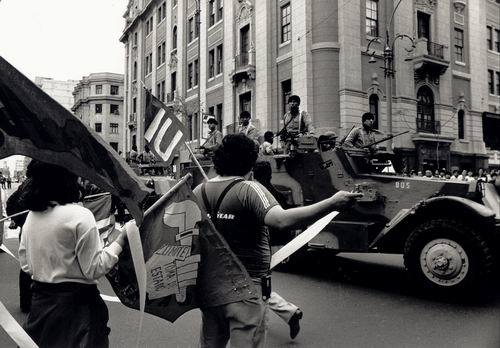


Lori Berenson, the U.S. activist convicted and imprisoned for collaborating with terrorist organizations, strikes a cord with me because 20 years ago I could have fallen into the same political trap. My sympathies lay with a generational band of political activists. But Peru's left wing was not the same in 1995 as it was in 1975 or 1985.
When I took up residence Peru in February 1974, my sympathies lay with change and empowerment. At first, the government of General Juan Velasco (1968-75) appeared to have its heart in the right place. But the military did not understand democracy or the economy. After Velasco was forced out in 1975, the second phase of the Revolutionary Government of the Armed Forces drew back from the most populist positions. It eventually had to return power to the civilians.

|
By the end of the 1970s, Peru had the most interesting left wing south of the Sandinistas' Nicaragua. Even though I might have not accepted the Left's political platform, the direction of change was right. The other options seemed a lot worse - APRA, AP, PPC, Opus Dei, provincial king makers or Lima elites. Even APRA under Alan Garcia's Social Democrat influence was creepy and faux. The leaders of Izquierda Unida, as it eventually became, were my generation - we liked the same music, books and movies. I enjoyed chatting with them. They gave the best insights and quotes about Peru and its current affairs. It was also an ecclectic left that embraced Mariategui and scoffed at the Soviet Union. They also seemed to have God on their side since Liberation Theology sprinkled holy water on the Popular Movement, as the loose coalition of shantytown residents, unions and peasants was called. On the other hand, many of the early leftwing activists on the fringes of IU and the popular movement ended up in MRTA or even sucked into Sendero.
While covering the Constituent Assembly (1978-79), I was asked to join POM-R, a Trotskyite party that was strong among the mineworkers at Southern Copper. No wonder the Troskyites were always being infiltrated by provocatuers. I was also suspected by Ricardo Letts of being a CIA informant. He told an mutual acquaintance that he expected me to pull out a taperecorder from under my coat. I always assumed that my private phone was tapped by state security or military intelligence.
By the end of the Garcia administration, the political landscape was in complete upheaval. The Left had shattered and the other parties were in remix mode. Alberto Fujimori came out of nowhere to trounce Mario Vargas Llosa for the presidency in 1990. Grassroots organizations were scaled back dramatically, caught between political violence and economic collapse. Solidarity became a luxury. Nearly 15 years of political violence had taken the luster off the leftwing rhetoric. Peruvians lost faith in politicians, especially those willing to kill for their goals. Marxism and command economies had proven inoperable in the real world. Revolutionary violence had lost all its romance. What's more, many of the revolutionary leaders had proven themselves no different than their elders. Although MRTA had claimed to be more humane than SL, they had shown to be no different in practice. They were dabbling in drug trafficking, blackmail and kidnapping.
By 1992 when Fujimori staged his autogolpe to shut down Congress and set his own rules for politics, the traditional dividing lines no longer made any sense. In many respects, Fujimori challenged the Peruvian entrenched interests more than MRTA. I can only image how difficult it was for many of my friends to adjust to this new world.
When Lori Berenson arrived in Peru in 1994, she had a tin ear - she could not hear the new political music in Fujimori's Peru. She equated the vocabulary of El Salvador and Nicaragua with MRTA's.
More importantly, Berenson crossed an invisible line. As a tourist, visitor or outside observer, she could not enter into the political realm. That's why her press conference speech went over so badly with Peruvians. She had not earned the right to participate. Some foreigners do get that right - missionaries, priests, nuns, for instance, can give sermons about the abuses of the system. They participate actively in community organizations. Some journalists and academics acquire that privilege too. I spoke out against political violence in my final years as a journalist .
At the end of her second trial in her closing statement, Berenson said that she loved Peru and its people. She cited the examples of Archbishop Romero and other Catholic martyrs for the poor. She had good, well-intentioned motives. But she had not earned the privilege to participate in Peru's political life. She parachuted into the country and told people they needed a revolution that would cost resources, blood and lives. That seemed pretty presumptuous for a 25-year-old to recommend because it ignored what had happened in the previous 15 years.